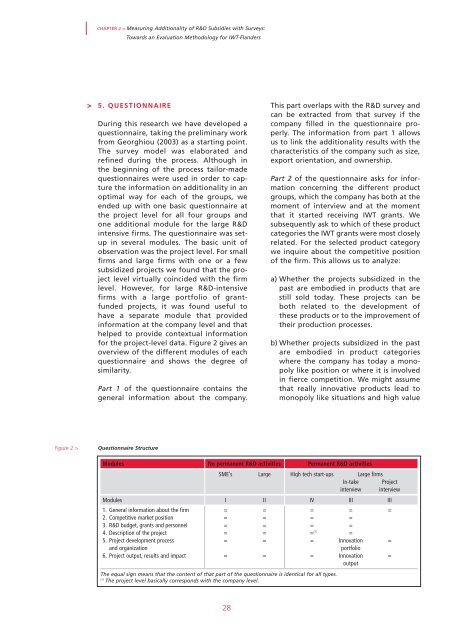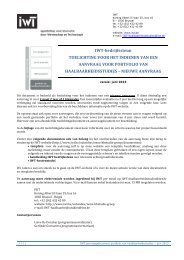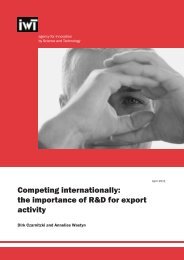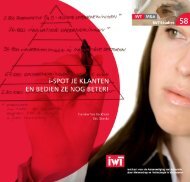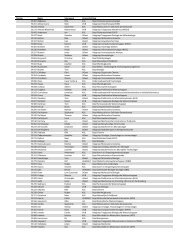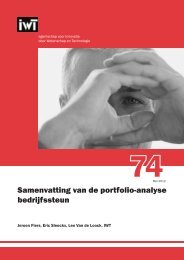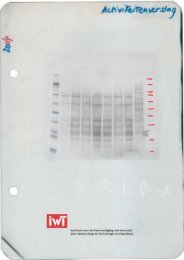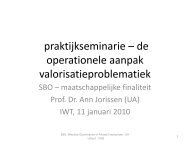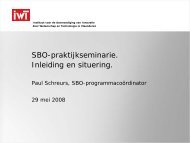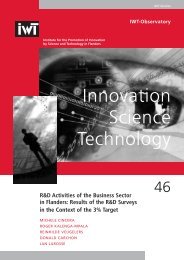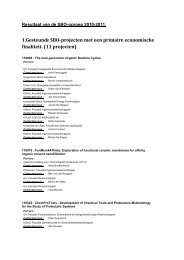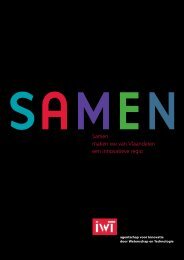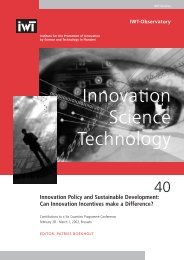The Evaluation of 'Behavioural Additionality' - IWT
The Evaluation of 'Behavioural Additionality' - IWT
The Evaluation of 'Behavioural Additionality' - IWT
You also want an ePaper? Increase the reach of your titles
YUMPU automatically turns print PDFs into web optimized ePapers that Google loves.
CHAPTER 2 > Measuring Additionality <strong>of</strong> R&D Subsidies with Surveys:<br />
Towards an <strong>Evaluation</strong> Methodology for <strong>IWT</strong>-Flanders<br />
><br />
5. QUESTIONNAIRE<br />
During this research we have developed a<br />
questionnaire, taking the preliminary work<br />
from Georghiou (2003) as a starting point.<br />
<strong>The</strong> survey model was elaborated and<br />
refined during the process. Although in<br />
the beginning <strong>of</strong> the process tailor-made<br />
questionnaires were used in order to capture<br />
the information on additionality in an<br />
optimal way for each <strong>of</strong> the groups, we<br />
ended up with one basic questionnaire at<br />
the project level for all four groups and<br />
one additional module for the large R&D<br />
intensive firms. <strong>The</strong> questionnaire was setup<br />
in several modules. <strong>The</strong> basic unit <strong>of</strong><br />
observation was the project level. For small<br />
firms and large firms with one or a few<br />
subsidized projects we found that the project<br />
level virtually coincided with the firm<br />
level. However, for large R&D-intensive<br />
firms with a large portfolio <strong>of</strong> grantfunded<br />
projects, it was found useful to<br />
have a separate module that provided<br />
information at the company level and that<br />
helped to provide contextual information<br />
for the project-level data. Figure 2 gives an<br />
overview <strong>of</strong> the different modules <strong>of</strong> each<br />
questionnaire and shows the degree <strong>of</strong><br />
similarity.<br />
Part 1 <strong>of</strong> the questionnaire contains the<br />
general information about the company.<br />
This part overlaps with the R&D survey and<br />
can be extracted from that survey if the<br />
company filled in the questionnaire properly.<br />
<strong>The</strong> information from part 1 allows<br />
us to link the additionality results with the<br />
characteristics <strong>of</strong> the company such as size,<br />
export orientation, and ownership.<br />
Part 2 <strong>of</strong> the questionnaire asks for information<br />
concerning the different product<br />
groups, which the company has both at the<br />
moment <strong>of</strong> interview and at the moment<br />
that it started receiving <strong>IWT</strong> grants. We<br />
subsequently ask to which <strong>of</strong> these product<br />
categories the <strong>IWT</strong> grants were most closely<br />
related. For the selected product category<br />
we inquire about the competitive position<br />
<strong>of</strong> the firm. This allows us to analyze:<br />
a) Whether the projects subsidized in the<br />
past are embodied in products that are<br />
still sold today. <strong>The</strong>se projects can be<br />
both related to the development <strong>of</strong><br />
these products or to the improvement <strong>of</strong><br />
their production processes.<br />
b) Whether projects subsidized in the past<br />
are embodied in product categories<br />
where the company has today a monopoly<br />
like position or where it is involved<br />
in fierce competition. We might assume<br />
that really innovative products lead to<br />
monopoly like situations and high value<br />
Figure 2 ><br />
Questionnaire Structure<br />
Modules No permanent R&D activities Permanent R&D activities<br />
SME’s Large High tech start-ups Large firms<br />
In-take Project<br />
interview interview<br />
Modules I II IV III III<br />
1. General information about the firm = = = = =<br />
2. Competitive market position = = = =<br />
3. R&D budget, grants and personnel = = = =<br />
4. Description <strong>of</strong> the project = = = (1) =<br />
5. Project development process = = = Innovation =<br />
and organization<br />
portfolio<br />
6. Project output, results and impact = = = Innovation =<br />
output<br />
<strong>The</strong> equal sign means that the content <strong>of</strong> that part <strong>of</strong> the questionnaire is identical for all types.<br />
(1)<br />
<strong>The</strong> project level basically corresponds with the company level.<br />
28


